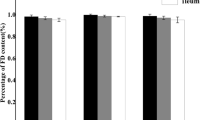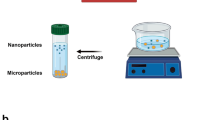Abstract
The viability of single and coaxial electrospray techniques to encapsulate model peptide—angiotensin II into near mono-dispersed spherical, nanocarriers comprising N-octyl-O-sulphate chitosan and tristearin, respectively, was explored. The stability of peptide under controlled electric fields (during particle generation) was evaluated. Resulting nanocarriers were analysed using dynamic light scattering and electron microscopy. Cell toxicity assays were used to determine optimal peptide loading concentration (~1 mg/ml). A trout model was used to assess particle behaviour in vivo. A processing limit of 20 kV was determined. A range of electrosprayed nanoparticles were formed (between 100 and 300 nm) and these demonstrated encapsulation efficiencies of ~92 ± 1.8 %. For the single needle process, particles were in matrix form and for the coaxial format particles demonstrated a clear core–shell encapsulation of peptide. The outcomes of in vitro experiments demonstrated triphasic activity. This included an initial slow activity period, followed by a rapid and finally a conventional diffusive phase. This was in contrast to results from in vivo cardiovascular activity in the trout model. The results are indicative of the substantial potential for single/coaxial electrospray techniques. The results also clearly indicate the need to investigate both in vitro and in vivo models for emerging drug delivery systems.







Similar content being viewed by others
References
Ferrari M. Cancer nanotechnology: opportunities and challenges. Nat Rev Cancer. 2005;5(3):161–71.
Bertling J, Blomer J, Kummel R. Hollow microspheres. Chem Eng Technol. 2004;27:829–37.
Mathiowitz E, Jacob JS, Jong YS, Carino GP, Chickering DE, Chaturvedi P, Santos CA, Vijayaraghavan K, Montgomery S, Bassett M, Morrell C. Biologically erodable microsphere as potential oral-drug delivery system. Nature. 1997;386:410–4.
Panyam J, Labhasetwar J. Biodegradable nanoparticles for drug and gene delivery to cells and tissue. Adv Drug Deliv Rev. 2003;55(3):329–47.
Luan X, Skupin M, Siepmann J, Bodmeier R. Key parameters affecting the initial release (burst) and encapsulation efficiency of peptide-containing poly (lactide-co-glycolide) microparticles. Int J Pharm. 2006;324:168–75.
Yang YY, Chung TS, Ng NP. Morphology drug distribution and in vitro release profiles of biodegradable polymeric microspheres containing protein fabricated by double-emulsion solvent extraction/evaporation method. Biomaterials. 2001;22(3):231–41.
Lemoine D, Preat V. Polymeric nanoparticles as delivery system for influenza virus glycoproteins. J Control Release. 1998;54:15–27.
Song CX, Labhasetwar V, Murphy H, Qu X, Humphrey WR, Shebuski RJ, et al. Formulation and characterization of biodegradable nanoparticles for intravascular local drug delivery. J Control Release. 1997;43:197–212.
Fessi H, Puisieux F, Devissaguet JP, Ammoury N, Benita S. Nanocapsule formation by interfacial deposition following solvent displacement. Int J Pharm. 1989;55:R1–4.
Barichello JM, Morishita M, Takayama K, Nagai T. Encapsulation of hydrophilic and lipophilic drugs in PLGA nanoparticles by the nanoprecipitation method. Drug Dev Ind Pharm. 1999;25:471–6.
Perez C, Sanchez A, Putnam D, Ting D, Langer R, Alonso MJ. Poly(lactic acid)-poly(ethylene glycol) nanoparticles as new carriers for the delivery of plasmid DNA. J Control Release. 2001;75:211–24.
Chronopoulou L, Fratoddi I, Palocci C, Venditti I, Russo MV. Osmosis based method drives the self-assembly of polymeric chains into micro and nanostructures. Langmuir. 2009;25:119406.
York P. Strategies for particle design using supercritical fluid technologies. Pharm Sci Technol Today. 1999;2:430–40.
Gu F, Zhang L, Teply BA, Mann N, Wang A, Radovic-Moreno AF, Langer R, Farokhzad OC. Precise engineering of targeted nanoparticles by using self-assembled biointegrated block copolymers. Proc Natl Acad Sci USA. 2008;105:2586–91.
Ye A. Surface protein composition and concentration of whey protein isolate-stabilized oil-in-water emulsions: effect of heat treatment. Colloids Surf B. 2010;78(1):24–9.
Yeo Y, Park K. Control of encapsulation efficiency and initial burst in polymeric microparticle systems. Arch Pharm Res. 2004;27(1):1–12.
Gulfam M, Kim JE, Lee JM, Ku B, Chung BH, Chung BG. Anticancer drug-loaded gliadin nanoparticles induce apoptosis in breast cancer cells. Langmuir. 2012;28(21):8216–23.
Valo H, Peltonen L, Vehviläinen S, Karjalainen M, Kostiainen R, Laaksonen T, Hirvonen J. Electrospray encapsulation of hydrophilic and hydrophobic drugs in poly(l-lactic acid) nanoparticles. Small. 2009;5(15):1791–8.
Zamani M, Prabhakaran MP, Ramakrishna S. Advances in drug delivery via electrospun and electrosprayed nanomaterials. Int J Nanomed. 2013;8:2997–3017.
Hartman RPA, Brunner DJ, Camelot DMA, Marijnissen JCM, Scarlett B. Jet break-up in electrohydrodynamic atomization in the cone-jet mode. J Aerolsol Sci. 2000;31:65–95.
Wu Y, MacKay JA, McDaniel JR, Chilkoti A, Clark RL. Fabrication of elastin-like polypeptide nanoparticles for drug delivery by electrospraying. Biomacromolecules. 2009;10:19–24.
Guarino V, Cirillo V, Altobelli R, Ambrosio L. Polymer-based platforms by electric field-assisted techniques for tissue engineering and cancer therapy. Expert Rev Med Devices. 2015;12(1):113–29.
Ruiz-Ortega M, Lorenzo O, Rupérez M, Esteban V, Suzuki Y, Mezzano S, Plaza JJ, Egido J. Role of the renin-angiotensin system in vascular diseases: expanding the field. Hypertension. 2001;38(6):1382–7.
Bunjes H, Drechsler M, Koch MHJ, Westesen K. Incorporation of the model drug ubidecarenone into solid lipid nanoparticles. Pharm Res. 2001;18:287–93.
Westesen K, Siekmann B. Biodegradable colloidal drug carrier systems based on solid lipids. In: Benita S, editor. Microencapsulation. Marcel Dekker: New York; 1996. p. 213–58.
Muller RH, Mader K, Gohla S. Solid lipid nanoparticles (SLN) for controlled delivery-a review of the state of the art. Eur J Pharm Biopharm. 2000;50:161–77.
Jenning V, Lippacher A, Gohla S. Medium scale production of solid lipid nanoparticles (SLN) by high pressure homogenisation. J Microencapsul. 2002;19:1–10.
Lippacher A, Muller RH, Mader K. Preparation of semisolid drug carriers for topical application based on solid lipid nanoparticles. Int J Pharm. 2001;214:9–12.
Zhang C, Qu G, Sun Y, Yang T, Yao Z, Shen W, Shen Z, Ding Q, Zhou H, Ping Q. Biological evaluation of N-octyl-O-sulfate chitosan as a new nano-carrier of intravenous drugs. Eur J Pharm Sci. 2008;33:415–23.
Benigni A, Cassis P, Remuzzi G. Angiotensin II revisited: new roles in inflammation, immunology and aging. EMBO Mol Med. 2010;2:247–57.
Green S, Roldo M, Douroumis D, Bouropoulos N, Lamprou D, Fatouros DG. Chitosan derivatives alter release profiles of model compounds from calcium phosphate implants. Carbohydr Res. 2009;344(7):901–7.
López-Herrera JM, Barrero A, Lopez A, Loscertales IG, Marquez M. Scaling laws. Aerosol Sci. 2003;34(5):535–52.
Taylor G. Disintegration of water drops in an electric field. Proc R Soc Lond Ser A. 1964;280(1382):383–97.
Montesano R, et al. Increased proteolytic activity is responsible for the aberrant morphogenetic behavior of endothelial cells expressing the middle T oncogene. Cell. 1990;62:435–45.
Le Mével JC, Olson KR, Conklin D, Waugh D, Smith DD, Vaudry H, Conlon JM. Cardiovascular actions of trout urotensin II in the conscious trout, oncorhynchus mykiss. Am J Physiol Regul Integr Comp Physiol. 1996;271:1335–43.
Lancien F, Wong M, Al Arab A, Mimassi N, Takei Y, Le Mével JC. Central ventilatory and cardiovascular actions of angiotensin peptides in trout. Am J Physiol Regul Integr Comp Physiol. 2012;303:311–20.
Barrero A, Ganan-Calvo AM, Davila J, Palacio A, Gomez-Gonzalez E. Low and high Reynolds number flows inside Taylor cones. Phys Rev E. 1998;58(6):7309.
Ku BK, Kim SS. Electrospray characteristics of highly viscous liquids. Aerosol Sci. 2002;33:1361–78.
Lastow O, Balachandran W. Novel low voltage EHD spray nozzle for atomization of water in the cone jet mode. J Electrostat. 2007;65:490–9.
Loscertales IG, Barrero A, Guerrero I, Cortijo R, Marquez M, Ganan-Calvo AM. Micro/nano encapsulation via electriped coaxial liquid jets. Science. 2002;295:1695–8.
Xie J, Ng WJ, Lee LY, Xie Jingwei, Wang CH. Encapsulation of protein drugs in biodegradable microparticles by coaxial electrospray. J Colloid Interface Sci. 2008;317:469–76.
Jiang H, Hu Y, Li Y, Zhao P, Zhu K, Chen W. A facile technique to prepare biodegradable coaxial electrospun nanofibers for controlled release of bioactive agents. J Control Release. 2005;108:237–43.
Kim SY, Lee H, Cho S, Park JW, Park J, Hwang J. Size control of chitosan capsules containing insulin for oral drug delivery via a combined process of ionic gelation with electrohydrodynamic atomization. Ind Eng Chem Res. 2011;50:13762–70.
Park I, Kim W, Kim SS. Multi-jet mode electrospray for non-conducting fluids using two fluids and a coaxial grooved nozzle. Aerosol Sci Technol. 2011;45:629–34.
Raiche AT, Puleo DA. Triphasic release model for multilayered gelatin coatings that can recreate growth factor profiles during wound healing. J Drug Target. 2001;9(6):449–60.
Christophersen PC, Zhang L, Yang M, Nielsen HM, Müllertz A, Mu H. Solid lipid particles for oral delivery of peptide and protein drugs I–elucidating the release mechanism of lysozyme during lipolysis. Eur J Pharm Biopharm. 2013;85(3A):473–80.
Scalia S, Mezzena M. Incorporation of quercetin in lipid microparticles: effect on photo- and chemical-stability. J Pharm Biomed Anal. 2009;49(1):90–4.
Christophersen PC, Zhang L, Müllertz A, Nielsen HM, Yang M, Mu H. Solid lipid particles for oral delivery of peptide and protein drugs II-the digestion of trilaurin protects desmopressin from proteolytic degradation. Pharm Res. 2014;31(9):2420–8.
Balls AK, Matlack MB, Tucker IW. The hydrolysis of glycerides by crude pancrease lipase. J Biol Chem. 1937;122:125–38.
Mosmann T. Rapid colorimetric assay for cellular growth and survival: application to proliferation and cytotoxicity assays. J Immunol Methods. 1983;65:55–63.
Altman FP. Tetrazolium salts and formazans. Prog Histochem Cytochem. 1976;9:1–56.
Acknowledgments
The authors would like to acknowledge PeReNE (EU-INTERREG) for supporting this study. The authors also thank Professor Simon Cragg for assistance with the SEM and TEM and Dr Simone Elgass for developing the HPLC method.
Author information
Authors and Affiliations
Corresponding author
Rights and permissions
About this article
Cite this article
Rasekh, M., Young, C., Roldo, M. et al. Hollow-layered nanoparticles for therapeutic delivery of peptide prepared using electrospraying. J Mater Sci: Mater Med 26, 256 (2015). https://doi.org/10.1007/s10856-015-5588-y
Received:
Accepted:
Published:
DOI: https://doi.org/10.1007/s10856-015-5588-y




